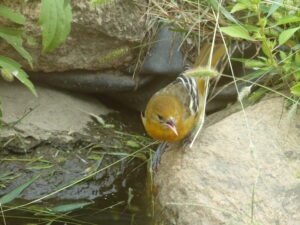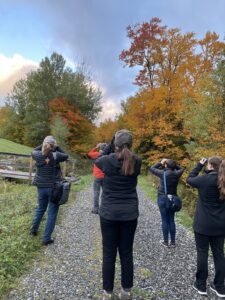While We Were Sleeping
We were tired on the evening of August 21. Crawling into bed at 9 pm we were oblivious to the traffic jam winging over our insulated roof. Late August. The fall bird migration has started. That night it picked up steam.

Birds stop for a drink and to fill up on the berries nearby.
In the morning we checked the BirdCast Migration Database and were astounded to learn that 883,000 birds crossed Linn County, Iowa, where we live, the evening before. Heading south, large numbers of birds began streaming overhead shortly after we turned off our reading lights. Migration usually starts just after sunset and peaks in the first couple of hours of darkness, but last night birds streamed over most of the night going south at an average speed of 26 miles an hour at an altitude of up to 2400 feet.
Technology Merged with Observation
How do we know? Well, we didn’t sit on the roof with night vision optics. We merely logged into the Cornell Laboratory of Ornithology’s Migration Dashboard at birdcast.info.
The technology is almost as fascinating as the information it reveals. The Live Migration videos show the action through the night. Fascinating!

Pause to listen and look. Binoculars help.
The Lab collects data from 143 radar installations scattered across the country. This provides a clear picture of the number of birds migrating at any given time, their direction and speed, and how high they are flying. Radar can’t determine species, but years of data collected by ground observation and compiled by the Lab through eBird helps give an accurate picture of the likely species on the move. The list shows that probably 14 species went overhead while we slept.
Until a few years ago we were casual birders. The amazing science and sharing the Lab of Ornithology provides fascinate us and has sensitized us to the marvel and beauty of birds, their amazing navigation ability, their adaptations, and, unfortunately, the threats they face.
Apps Enhance Birding Experience
We have the Lab’s Merlin and Bird apps on our phone. The first is a pocket-sized field guide packed with more information than old paper field guides ever were able to provide. It helps us identify an unknown species, see its range, and even hear its calls and songs. A new feature helps identify birds by their song. Click it on and hold the phone toward where the call is coming from, and it identifies the species, usually correctly.
eBird enables us to easily compile a list of birds sighted on a particular day and forward our data to the Lab. Thousands of birders worldwide send their data, giving the Lab invaluable information on where birds are and how they move……as well as population trends.
Technology and Birds! What’s Not to Love?
Love technology? Love birds? These wonderful tools provided free from the Cornell University Laboratory of Ornithology merge the two. It’s a portal to many pages and other sites that include everything from nest webcams to detailed information about each species. Kudos to the Lab.


Heap good medicine
Thanks, Marty. Hope you are doing great.